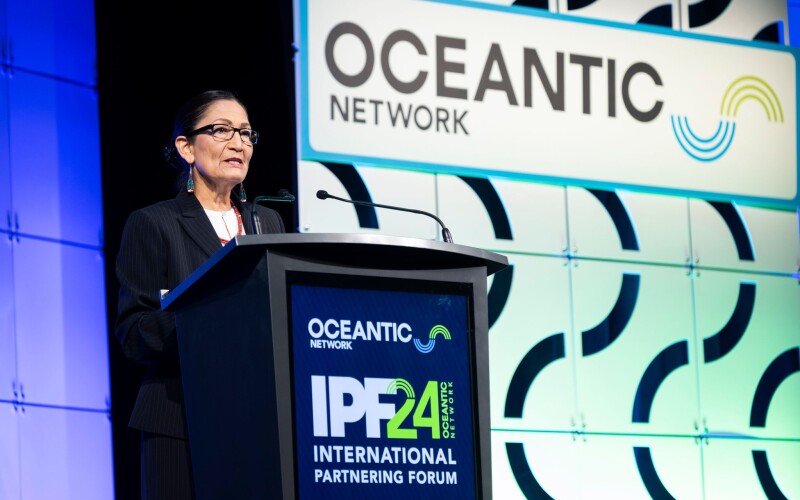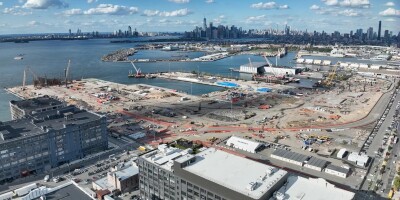Updated regulations for offshore wind development announced by U.S. Secretary of the Interior Deb Haaland Wednesday include a five-year planning framework that could bring 12 new offshore wind lease sales by 2028, according to Interior officials.
"By modernizing and updating these regulations, we are paving the way for the safe and efficient deployment of offshore wind projects, providing clarity for developers while continuing to protect important natural and cultural resources," said Haaland, speaking at the International Partnering Forum offshore wind conference in New Orleans.
The federal Bureau of Ocean Energy Management and Bureau of Safety and Environmental Enforcement finalized updated regulations for renewable energy development on the U.S. Outer Continental Shelf, with the proposal to be published in the Federal Register in coming days.
“The final rule increases certainty and reduces the costs associated with the deployment of offshore wind projects by modernizing regulations, streamlining overly complex processes and removing unnecessary ones, clarifying ambiguous regulatory provisions, and enhancing compliance requirements,” according to a summary from BOEM.
“Over the next 20 years, the final rule is expected to result in cost savings of roughly $1.9 billion to the offshore wind industry, savings that can be passed onto consumers and used to invest in additional job-creating clean energy projects.”
According to BOEM, the final rule:
- Eliminates unnecessary requirements for the deployment of meteorological buoys
- Increases survey flexibility
- Improves the facility design, fabrication, and installation certification and verification process
- Establishes a public renewable energy leasing schedule
- Reforms BOEM’s renewable energy auction regulations
- Tailors financial assurance requirements and instruments
- Clarifies safety management system regulations
- Clarifies and strengthens oversight of critical safety systems and equipment
Meanwhile, New York State officials are moving to regroup after cancelling three provisional contracts April 19 with developers holding federal leases in the New York Bight. Prospects for those planned turbine arrays were undercut when turbine manufacturer GE Vernova made a decision to cancel its plan for supersized 18-megawatt turbines the developers planned to use, according to reporting by Politico and E&E News.
In New Orleans, Doreen Harris, president and CEO of the New York State Energy Research and Development Authority presented details about New York's upcoming fifth offshore wind solicitation, and said the state will request another lease sale by BOEM in the New York Bight.
Despite the latest setback New York Gov. Kathy Hochul pressed on this week, announcing new efforts on offshore wind development.
A $200 million “supportive manufacturing and logistics request for proposals” was opened to support investments in infrastructure and manufacturing to develop a local offshore wind supply chain in New York. State officials are preparing a new request for information to help develop a fifth round off offshore wind energy solicitations, looking to replace the earlier New York Bight proposals.
Wind power developers say permitting delays are one more hurdle for a U.S. market already dealing with escalating costs and supply chain issues.
"The final modernization rule will streamline the permitting process and reduce regulatory barriers for developers,” said Anne Reynolds, American Clean Power’s vice president for offshore wind. “It will also lead to greater collaboration between federal, state, and local stakeholders, ensuring that offshore wind projects are developed in a sustainable and responsible manner.”
"Additionally, the new leasing schedule announced by BOEM helps provide the needed business certainty for future planning, especially as we build out a domestic supply chain. We commend the Department of the Interior for accelerating the full potential of offshore wind energy in the United States."
As offshore wind advocates praised Haaland’s announcement, U.S. offshore operators said Washington needs to keep moving oil and gas lease sales as well.
"Any actions to delay or reduce Gulf of Mexico oil and gas lease sales could inadvertently delay offshore wind lease sales. Periods of inactivity in lease sales—whether for wind or oil and gas—only increase uncertainty and risk driving investment dollars overseas. Sustaining regular lease sales for all energy sources ensures energy continuity, promotes economic growth, and maintains America's competitiveness in the global energy market.”





